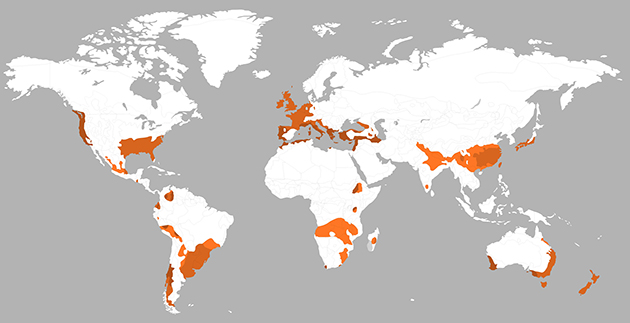.jpg) © Paul Ott
© Paul Ott
PROJECT INFO
Building type:
Residential
Year:
2013
Project Status:
Built
Gross Area:
1600 Sqm
Certificates:
Climatic zone:
Temperate
MY LAST SEEN PROJECTS
PROJECT DESCRIPTION
This visionary “Case Study House” featuring the first algae bioreactor façade world-wide was realized in the frame of the International Building Exhibition (IBA) in Hamburg in 2012 and 2013. As a “Smart Material House”, it combines intelligent materials and technologies with new typologies of living.
Architectural masterpiece
Setting the scene with its two red-white-red-white striped sunny-sided algae bioreactor façades, this janiform structure is reminiscent of the colours associated with the Free and Hanseatic city of Hamburg, or if you like, with the Alpine Republic of Austria – but above all – they emphasize the uniqueness of this multi-storey residential building and its prototypical method of producing energy and regulating light and sun-shading. At close range, the façades – oscillating from afar through the constantly growing algae – start to move; bubbles forming through the supply of carbon dioxide and nitrogen, as well as the permanently essential circulation of water containing aerosol-like microalgae, seem to suggest that biomass production could be a solar-powered art installation, steadily bubbling along.
From afar, you can already read two giant speech bubbles with black letters against a white background shown on the two green shady façades with their tiny windows, the first bubble asking “Photosynthesis?” and the second replying “Cool!”. “Realisation also means communication”, SPLITTERWERK engineers, architects and artists assert and let the top of two penthouse façades entwine with grape-vine ornaments.
Residential typology
Whether it be Mies van der Rohe’s flowing space, Frank Lloyd Wright’s open floor plan, or Adolf Loos’s “Raumplan”, not to mention Margarete Schütte-Lihotzky’s economical Frankfurt Kitchen – their contemporary development is incorporated in the intelligent residential typologies of the “Case Study House” Clever Treefrog. In the adjustable structure of these new residential typologies, functional spaces can be alternately or simultaneously attached or detached on demand. The Loos plan thus becomes an individual and time-oriented living plan. The appearance of living space is dominated by user-oriented living requirements and changes of programme. Accordingly, “Smart Spaces” develop from the “Hamburg apartment” and “Milan apartment” with different typologies of re-configurable floor plans.
AWARDS
SUSTAINABILITY FEATURES
High efficient façade
Biomass heating systems
Ground Source Heat Pump
SUSTAINABILITY STRATEGY
Energy hybrid
Thanks to the hybrid functionality of its algae façade, this building combines various processes of regenerative energy production to create a sustainable circulation system: solar heat, geothermal energy, biomass and a fuel cell together form three storable energy sources in the form of heat, electricity and biogas. Moreover, the façade fulfils all functions expected of a conventional building cladding: it not only acts as a thermal and sound insulation, but also as a sun shield.
130 translucent, plate-shaped glass containers – so-called photo bioreactors – are composed of two structurally bonded glass panes, the outer structural glass pane having been manufactured as a photovoltaic glass module. In the container itself, microalgae are cultivated in a watery culture medium that then perform photosynthesis by absorbing natural light, subsequently also producing biomass when supplied with carbon dioxide and the nutrients nitrogen and phosphor. They are able to store carbon dioxide and produce biogas in the in-house fuel cell which generates 4,500 kWh per year.
Moreover, the photo bioreactors’ solar thermal function additionally produces around 32 MW heat per year that can either be directly used in the house or fed into the local power network, or alternatively, temporarily stored underground.
ENERGY DATA
Energy consumption:
N/A (N/A )
Consumption type:
Annual carbon footprint:
N/A (N/A )
Climate zone:
Temperate
Min. temperature =
-1.4
Max temperature =
+ 22.2
RH =
N/A

CLIENT
Client:
KOS Wulff Immobilien GmbH
DESIGNERS
Architect:
SPLITTERWERK
Architect:
SPLITTERWERK , Mark Blaschitz , Edith Hemmrich , Max Jüngling , Josef Roschitz , Ingrid Somitsch
CONSULTANTS
Building physics consultant:
Arup GmbH
Energy consultant:
Strategic Science Consult GmbH , IMMOSOLAR GmbH
Specialist consultant:
inHaus GmbH , German technologies and engineering conceptz , Berner Fachhochschule , Holz und Bau , BASF Aktiengesellschaft , Bayer Material Science , Fielitz GmbH , Fraunhofer ISC , Glas Trösch GmbH , TU Dresden , OKALUX GmbH
Structural Engineer:
B+G Ingenieure
CONTRACTORS
OTHER PROJECTS BY TEAM
SIMILAR PROJECTS




Bodø, Norway | 2013


Malmö, Sweden | 2001
.jpg)

.jpg)

.jpg)

Traversa di Via Assunta, 00042 Anzio RM, Italia | 2016


San Pedro Garza García, Nuevo Leon, Mexico | 2019




62011 Cingoli MC, Italia | 2011

Via Emanuela Loi, 25, 00143 Roma RM, Italy | 2025

Via Emanuela Loi, 25, 00143 Roma RM, Italy | 2025

Via Emanuela Loi, 25, 00143 Roma RM, Italy | 2025

Via Emanuela Loi, 25, 00143 Roma RM, Italy | 2025